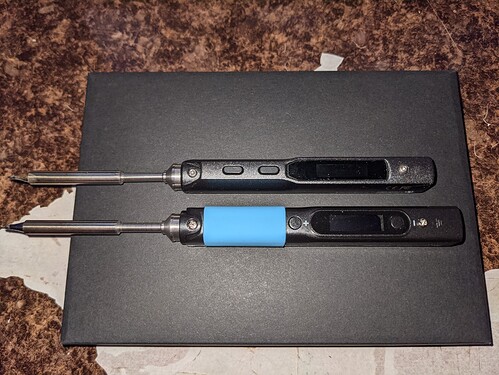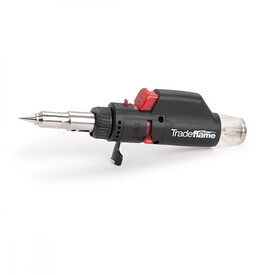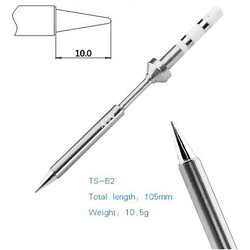Informal Pinecil review for those that were interested (otherwise feel free to disregard):
Finally got it in the mail today, ~noon. That marks 34 days total from order til delivery. Lesson here, definitely go for the DHL shipping if you want to get it in a reasonable length of time.
I used it for about 3 hours today, repairing a power supply for a TV of a family friend.
(TS100 on top, Pinecil on the bottom)
Fit and finish:
Overall, it feels fine. The plastic maybe feels a tiny bit lower quality than the TS100 I’d say, but the overall construction is very very similar. The OLED display on mine has a little bit of weirdness to it, almost like the adhesive was a tiny bit messed up on the edges. This is visible in the picture above, on the right side. However, this picture is using flash. With the iron assembled, this is not visible with the naked eye, at least with the lighting in my home. I didn’t notice this myself until taking the iron apart, and seeing the bare display. When the iron is on, there is no issues either, the screen looks fine.
It’s difficult to capture on camera, but display is overall quite sharp, and decently bright. Pretty much identical to the display in the TS100.
The silicon grip feels nice, and I assume it’ll last a long time.
My last note in this category is that the Pinecil uses all phillips screws, while the TS100 is all hex/allen. This is nice for quickly swapping tips, but I fear for the longevity of the phillips screws, and worry about them stripping. This is another trade-off though, I’m sure some would rather have the convenience. I will say, not having to dig out my iFixit screwdriver set to swap tips is nice, as I lost the allen key for my TS100 long, long ago. You’re also not likely to have to take the iron apart very often, if at all. I just did it out of curiosity.
Comfort/Ergonomics:
The silicone grip is a good improvement over the TS100, especially for those used to using a normal soldering station (the grip shape reminds me of many Weller irons I’ve used). My only gripe with comfort is the button placement. Due to the thin pencil-like grip of the TS100, my thumb naturally rested on the plus button, which acts as the temperature boost button. This made it very easy to increase temp temporarily without adjusting my grip. This doesn’t work on the Pinecil, I have to shift my grip upward a bit to hold the button. Not a huge deal, and I’m sure many will find the ergonomic trade-off worth it, in exchange for the thicker silicone grip. The minus button is impossible to reach one-handed, so if you want to do actual temperature adjustment, you’re probably gonna want a second hand free. This isn’t any different from a normal soldering station, where a second hand is needed regardless, so not a big deal to me.
Regarding actual soldering performance and feel, it’s really nice, if you’ve used a TS100, it’s a pretty much identical experience. This is to be expected, since the tips (with integrated heaters) are identical, and are interchangeable.
Performance:
Hooked up to my 60W USB PD 3.0 charger via type C, this iron worked incredibly well. Heated up to 350C in less than 10 seconds, and had no issues quickly boosting to 420C (default boost temp, adjustable in the settings). Especially when traveling, or during events like hackathons, being able to use the same charger for my phone, laptop, and soldering iron, will be incredibly handy. QC or PD 3.0 powerbanks are also going to be amazing for this, as long as they can output enough power.
I also tested it with a normal 19V power supply via the barrel jack, the same supply I use with my TS100, and that worked fine as well, pretty much identically to the TS100.
Using my phone’s included charger, which is only 18W, it managed to get to over 200C, but couldn’t quite get to my desired temp. I’d say anything 30W or above should probably be good enough.
Software:
Firmware is the same as my TS100 is running, the Ralim firmware. It’s using a very new version, newer than my TS100, and the feature set is great, has plenty of customization in the settings (advanced display during soldering, shows input voltage by default, default boost temp, etc).
My only issue software wise so far is a bug with the accelerometer. The display orientation has 3 settings, L, R, and A. L and R are for which hand you’re soldering with, so that the screen has the correct side facing upwards. A is auto mode, which is supposed to use the accelerometer to determine which hand it’s in. This works well on my TS100, but when I tried it on the Pinecil, it just flipped to left handed and stayed that way. I almost always just solder with my right hand, and it’s just a bug I’m sure will be fixed, but wanted to mention it. I don’t even have auto mode turned on on my TS100, since I’ve found that it can be a bit distracting when I’m soldering in weird spots (such as upside down under my dash).
The firmware is all open-source, so I could always even just fix the bug myself, which is nice. Just flashes over USB, no external programmer needed.
Overall:
Especially for the cost, this thing is a really, really compelling option. Even including shipping from China, it still cost less than half of my TS100 a few years ago. Given that the included firmware is the first version for the Pinecil, I’m sure that’ll mature even more as well.
Especially for someone wanting a good temp-controlled portable iron, this is a fantastic choice. It’s also a great option for anyone who currently has a soldering iron without temperature control, and doesn’t want to pay for a proper soldering station, or someone who doesn’t have the desk space for one.
RISC-V is just a bonus 



